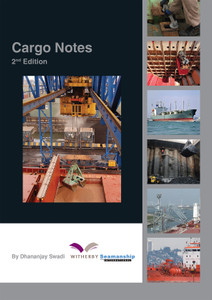
This informative book is designed to support students working towards their MCA Certificate of Competency exams. It is for any seafarer wishing to refresh or update their knowledge, covering navigation, cargo handling and stowage, emergency response and onboard ship operations.
This book is based on the MCA examination syllabus and has been written to make the syllabus less daunting. Its structured approach to studying – using tables and bullet points to highlight key pieces of information – will help the reader gain confidence in the topic areas.
It also brings together links to publications produced by the IMO, the MCA, the International Chamber of Shipping, P&I Clubs and other non-governmental organisations, to help the reader source additional knowledge and gain a deeper understanding of each topic.
The purpose of this book is to support students studying towards their Maritime and Coastguard Agency professional exams.
The contents of the book are structured around the MCA examination syllabus. The book has been written to provide a brief overview of each topic. Tables and bullet points have been used as I am a great advocate of the ‘flashcard’ study technique and this style lends itself to that.
There are links to primary sources of information and documents which will help you gain a deeper understanding of each topic.
There are so many excellent publications in the public domain produced by the likes of IMO, the MCA, International Chamber of Shipping, P&I clubs and other non-governmental organisations that can really develop your knowledge and be taken forward in your professional environment.
The reason why I wanted to bring this book together was because on first reading, the syllabus can seem quite daunting. By taking a structured approach to your studying and having knowledge of where to find key sources of information you can soon gain confidence in the topic areas.
Section 1 – Navigation
1 Passage Planning
2 Navigational Charts and Publications
3 Radio Navigational Warnings
4 Ships Routeing Information
5 Mandatory Reporting Systems
6 IALA Systems of Maritime Buoyage
7 Electronic Navigation Systems
8 Electronic Chart Systems
9 Radar and ARPA
10 The Azimuth Mirror
11 Marine Sextant
12 Sources of Meteorological Information
13 Meteorological Instruments
14 Characteristics of Weather Systems
15 Reporting and Recording Systems
16 The Principles of Navigational Watchkeeping
17 International Regulations for Preventing Collisions at Sea (COLREGS)
18 Practical use of RADAR and ARPA
19 Bridge Equipment
20 Steering Control Systems
21 The Bridge Procedures Guide
22 Compasses
23 Gyro Compass
24 Associated Equipment
25 Manoeuvre the Ship
26 Preparation and Duties
27 Use and Care of Mooring Lines and Associated Equipment
28 Ship Handling
29 Turning Short Round
30 Action in the Event of a Failure
31 Proper Procedures for Anchoring
Section 2 – Cargo Handling and Stowage
32 Use and Care of Synthetic Fibre and Wire Ropes
33 IMO Conventions and Guidelines Concerning the Safe Handling of Cargoes Onboard the Vessel
34 Carriage of Goods by Sea
35 Use of the Hydrometer
Section 3 – Response to Emergencies
36 Response to Navigational Emergencies
37 Precaution for the Protection and Safety of Passengers
38 Use of the International Aeronautical and Marine Search and Rescue (IAMSAR) Manual
39 Distress and Emergency Signals
40 Search and Rescue Around the UK and Worldwide
41 Organisational Procedures for Emergency Parties and Drills
42 Knowledge of Fire Prevention and Fire-Fighting Appliances
43 Classes of Fire
44 Properties of Fire Extinguishers
45 Use and Care of Life Saving Appliances
46 Markings on Survival Craft and Associated Equipment
47 Launch and Manage Survival Craft
48 Knowledge of SOLAS Training Manual
49 Basic Principles of Survival
50 Emergencies in Port
51 Sources of Medical Information
52 International Code of Signals and IMO Standard Marine Communication Phrases
53 IMO Standard Marine Communication Phrases
Section 4 – Onboard Ship Operations
54 MARPOL Prevention of Pollution
55 MARPOL Precautions to Prevent Pollution from Ships
56 The Shipboard Oil Pollution Emergency Plan (SOPEP)
57 Contents of SOPEP Plan
58 Garbage Management Plan
59 Anti-Pollution Equipment
60 Fundamentals of Watertight Integrity
61 Preparations for Heavy Weather
62 Legislative Requirements
63 Merchant Shipping Health and Safety Legislation
64 IMO Conventions
65 International Safety Management Code for the Safe Operation of Ships and for Pollution Prevention (ISM)
66 The Maritime Labour Convention
67 Flag State and Port State
Witherby Publishing Group Ltd
Witherbys titles are developed using scripts developed by technical experts that are peer reviewed within work groups. Typically, they seek to improve understanding of the regulations, recommendations and guidelines issued by Industry.
Witherbys staff have significant expertise in the fields of navigation and hazardous cargoes as well as in the presentation of complex subjects in a graphic and easy to understand manner.
Angus Ferguson
Angus Ferguson gained his Master Mariner Certificate of Competency before moving into maritime education. In January 2020, he founded Onboard Maritime, a digital maritime training company that aims to make quality learning accessible to maritime professionals, no matter where they live or work in the world.
- Number of Pages:
- 214
- ISBN:
- 9781856098427
- Binding Format:
- Paperback
- Book Height:
- 210 mm
- Book Width:
- 148 mm
- Weight:
- 0.6 kg
- Author:
Angus Ferguson
- Published Date:
- October 2019
- Preview:
- Yes
- Publication Date:
- October 2019
 Witherbys.com
Witherbys.com





